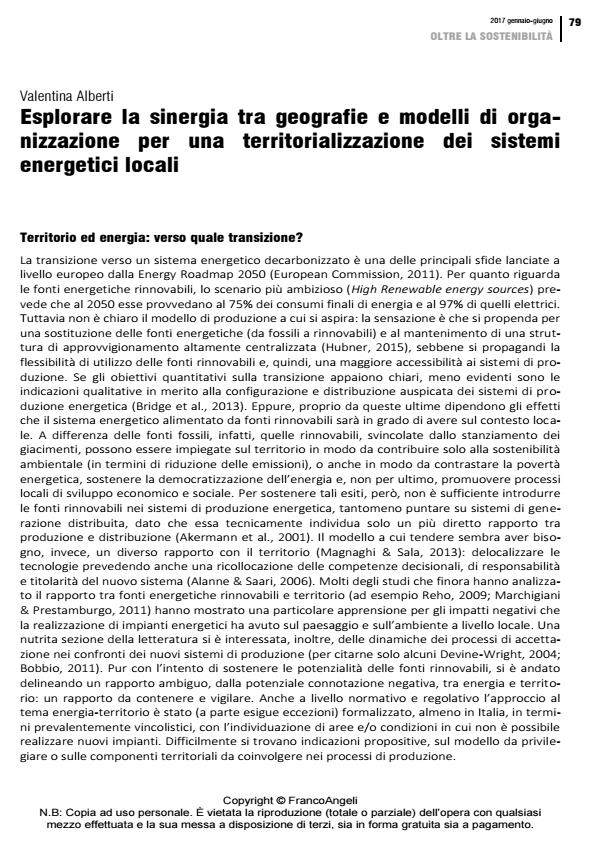Esplorare la sinergia tra geografie e modelli di organizzazione per una territorializzazione dei sistemi energetici locali
Journal title CRIOS
Author/s Valentina Alberti
Publishing Year 2017 Issue 2017/13
Language Italian Pages 12 P. 79-90 File size 1037 KB
DOI 10.3280/CRIOS2017-013007
DOI is like a bar code for intellectual property: to have more infomation
click here
Below, you can see the article first page
If you want to buy this article in PDF format, you can do it, following the instructions to buy download credits

FrancoAngeli is member of Publishers International Linking Association, Inc (PILA), a not-for-profit association which run the CrossRef service enabling links to and from online scholarly content.
- Ackermann T., Andersson G., Söder L. (2001). Distributed generation: a definition. Electric Power Systems Research, 57 (2001), 195-204. DOI: 10.1016/S0378-7796(01)00101-8
- Adil A. M., Ko Y. (2016). Socio-Technical evolution of Decentralized Energy System: A critical review and implications for urban planning and policy. Renewable and Sustainable Energy Review, 57, 1025-1037.
- Alanne K., Saari A. (2006). Distributed energy generation and sustainable development. Renewable & Sustainable Energy Reviews, 10/6, 539-558.
- Bagliani M., Dansero E., Puttilli M. (2012). Sostenibilità territoriale e fonti rinnovabili. Un modello interpretativo. Rivista Geografica Italiana, 119, 291-316.
- Becker S., Kunze C. (2014). Transcending community energy: collective and politically motivated projects in renewable energy (CPE) across Europe. People, Place and Policy, 8/3, 180-191.
- Bobbio L. (2011). Conflitti territoriali: sei interpretazioni. TeMA, 4, 79-88. -- DOI: 10.6092/1970-9870/569
- Bridge G., Bouzarovski S., Bradshaw M., Eyre N. (2013). Geographies of energy transition: Space, place and low-carbon economy. Energy Policy, 53, 331-340. --
- Bulsei G.L. (2010). Le sfide della sostenibilità. Risorse ambientali, qualità sociale, partecipazione pubblica. Firenze: Alinea.
- Dematteis G., Governa F., Vinci I. (2003). La territorializzazione delle politiche di sviluppo. Un’applicazione del modello SLoT alla Sicilia. Ar-chivio di studi urbani e regionali, 77, 33-74.
- Devine-Wright P. (2005). Beyond NIMBYism: to-wards an integrated framework for understanding public perceptions of wind energy. Wind Energy, 8, 125-139.
- Devine-Wright P. (2007). People centred eco-design: consumer adoption of low and zero carbon products and systems. In: Murphy J. (ed.) (2007), Governing Technology for Sustainability, London: Earthscan.
- Devine-Wright P., Wiersma B. (2013). Opening up the ‘local’ to analysis: exploring the spatiality of UK urban decentralized energy initiatives. Local Environment, 18/10, 1099-1116. DOI: 10.1080/13549839.2012.754742
- European Commission (2011). Communication from the Commission to the European Parliament, the Council, the European Economic and Social Committee and the Committee of the Regions. Energy Roadmap 2050. --http://www.europarl.europa.eu/meet-docs/2009_2014/documents/com/com_com(2011)0112_/com_com(2011)0112_en.pdf.
- Hübner F. (2015). A bright future for fossil energy in the EU?. In: Rosa Luxemburg Stiftung Annual report.
- Magnaghi A., Sala F. (2013). Il territorio fabbrica di energia. Milano: Wolters Kluer Italia.
- Marchigiani E., Prestamburgo S. (2011). Energie rinnovabili e paesaggi. Strategie e progetti per la valorizzazione delle risorse territoriali. Milano: FrancoAngeli.
- Murphy J. (2007). Governing Technology for Sus-tainability. In: Murphy J. (ed.) (2007), Governing Technology for Sustainability, London: Earthscan.
- Puttilli M. (2014). Geografie delle fonti rinnovabili. Energia e territorio per un’eco-ristrutturazione della società. Milano: FrancoAngeli.
- Raffestin C. (1980). Pour une géographie du pouvoir. Paris: Litec.
- Reho M. (2009). Fonti Energetiche Rinnovabili, Ambiente e Paesaggio Rurale. Milano: FrancoAngeli.
- Schreuer A., Weismeier-Sammer D. (2010). Energy cooperative and local ownership in the field of renewable energy technologies: a literature review. In: Research Reports/RICC, 4. Vienna: WU Vienna University of Economics and Business.
- Turco A. (1988). Verso una teoria geografica della complessità. Milano: Unicopli.
- Vandevyver H., Stremke S. (2012). Urban planning for a Renewable Energy Future: Methodological Challenges and Opportunities from a Design Per-spective. Sustainability, 4, 1309-1328.
Valentina Alberti, Esplorare la sinergia tra geografie e modelli di organizzazione per una territorializzazione dei sistemi energetici locali in "CRIOS" 13/2017, pp 79-90, DOI: 10.3280/CRIOS2017-013007